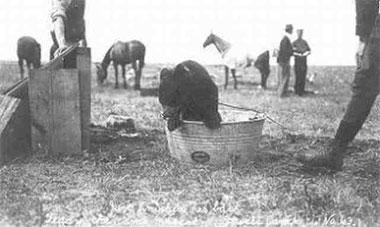Shilo Landmarks
Sewell Camp (Shilo) During WW1 (continued)
 |
 |
| Troop inspection - Camp Sewell 1915 | Camp mascot at Sewell - 1915 |
Camp Hughes
Camp Sewell was re-designated as Camp Hughes in 1915 when the CPR re-named their station at Sewell. It was a compliment to Lieutenant General Sir Sam Hughes, KCB, who was Minister of Militia and Defense from 1911 to 1916. Approximately 30,000 men trained at the camp in 1915 and again in 1916 as their battalions concentrated prior to being shipped to Europe. The camp saw little use between 1917 and 1919 as training concentrated upon sending small drafts of men to the training brigades in England rather than raising complete battalions in Canada. These reinforcements were generally trained in Winnipeg using the St. Charles range.
Following the war, Camp Hughes continued in use as a militia training area. The only regular artillery unit in Manitoba was C Battery RCHA, in Winnipeg 1919-1939). C Battery deployed to Camp Hughes every summer in order to conduct its own exercises and to support militia artillery training. The exact impact areas for this training cannot be confirmed, but most likely included the Douglas Marsh and may have included portions of the present training area. In addition to C Battery, the PPCLI and a squadron of the LdSH (RC) were also stationed in Winnipeg in the inter-war years and trained at Camp Hughes and Shilo. D Coy, PPCLI were stationed in Winnipeg in 1920. In 1939, C Coy replaced HQ and A Coy prior to mobilization. Thirteen summer concentrations occurred at Camp Hughes in the 14 years from 1920 to 1933. Camp Hughes was dismantled in 1934 and all that remains now is a small cemetery marking the graves of those soldiers who died while serving there. In recent years, a transmitter site has been set up in that area.
Shilo During WW2
In 1928, the site of the current rifle ranges was surveyed and the base was formally established on July 25th. Further surveys were carried out in 1932 and established most of the area we now know as CFB Shilo. The survey not only covered the ground, but also included the discovery and planning of the camp water supply, a supply that is in use today and emanates from a vast underground lake...a legacy of the post-glacial age. In 1931, construction began on Camp Shilo, partially as a relief project due to the Depression. The first summer camp for the militia was held in the present training area in July 1934 for militia artillery, cavalry and machine gun units. During that summer, the infrastructure at Camp Hughes was demolished and those buildings that were worth salvaging were moved to the present site of Shilo. Summer concentrations then occurred every year in Shilo up to and including 1939.
Click on individual images to change view

